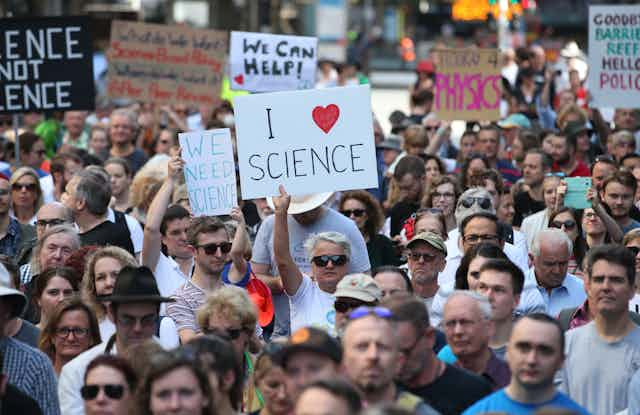The 2017 March for Science was a powerful political statement by scientists. The marchers opposed political interference, budget cuts and lack of support for science at a government level.
More commonly, though, scientists stay in their labs and avoid the public political spotlight.
CSIRO scientist John Church – who initially acted as an individual (not a representative of his research institution) to “stand up for science” in 2015 – is cited as a recent example of the career ramifications that can flow from public activity.
Actually, he’s not alone. For years, outspoken scientists have encountered career difficulties and personal repercussions.
But climate science and the advent of digital and social media shape how scientists speak publicly about science now.
Decades of attacks on scientists
Science, an effective system for generating knowledge, is inextricably linked with economic, military and political activity.
For decades, scientific research has been shaped by the agendas of the most powerful groups in society, primarily governments and corporations. The period following World War II has been described as the era of “big science” with generous funding for research.
Periodically though, research findings connect with emerging social movements.
In the early 1970s, CSIRO scientist Peter Springell reported that he was blocked from publishing articles on environmental topics using his CSIRO affiliation, after he criticised CSIRO’s lack of environmental research.
According to Springell, he was targeted with a punitive transfer and recommended for dismissal. To my knowledge, there has been no public response from CSIRO to this claim.
Claims have also been made regarding repercussions after scientists spoke up about hazards from nuclear power, genetic modification, electromagnetic fields or using treated sewage sludge on agricultural land.
In several scientific fields, there is a pattern of suppression of dissent. In many of these cases, scientists have challenged either the orthodoxy in the field or policy positions.
Whether these challengers are right or wrong is not the focus of this analysis. Rather, the point is that their claims should be evaluated scientifically and that the scientists should not be subject to unfair treatment.
A survey of Australian environmental scientists undertaken in the mid 1990s contained 70 participants. Over half of respondents believed that scientists who spoke out about environmental issues could jeopardise their research funding or career prospects.
Surveys conducted in 2002/2003 in “a sample of researchers drawn from prestigious U.S. academic departments” reported that “nearly half the researchers felt constrained by explicit, formal controls, such as governmental regulations and guidelines codified by universities, professional societies, or journals”.
And then came climate change
In the past two decades, the usual pattern of scientific research shaped by social interests has been challenged in several ways. A key factor is climate science. The scientific orthodoxy today – that global warming is occurring and largely due to human influences – is contrary to the interests of the fossil fuel industry.
Because climate change is the world’s most prominent environmental issue, this causes unprecedented tensions in countries such as Australia and the US, where some politicians appear sympathetic to climate scepticism.
Under the US administrations of George W Bush and Donald Trump, this tension has been exacerbated by concerns about overt political interference in research agendas.
Removal of references to climate change on the White House website is cited as one of the triggers for the global March for Science movement.
Control and trust
The emergence of open access research published online, plus social media has changed how scientific findings are distributed and read, and who drives dialogues about science. Scientists, governments and other groups can’t control conversations about the implications of research in this environment.
Action groups can more readily access research findings, and use them to support their causes. This occurs in all sorts of fields.
Public trust in authorities is in decline, including those in government, science and health.
Yet another factor is the increasing role of whistleblowing. Speaking out in the public interest occurs in all sorts of areas, including schools, police, the military, the public service, churches and businesses. So why not in scientific fields?
Public interest leaking — or anonymous whistleblowing — has received enormous attention due to WikiLeaks and the spectacular disclosures by Chelsea Manning and Edward Snowden. It’s an option some scientists may choose to take.
Group and anonymous activity
Systems of power have always led to attacks on scientists who are seen as a threat by governments, corporations or (in recent decades) members of identity groups such as transgender activists. Most of these cases involve both power and a clash of worldviews.
There is safety in numbers, and this is why the March for Science is so important. Reports say that thousands of scientists across more than 600 cities stood up for science on April 22, 2017.
It remains risky to speak out as an individual, so the option of leaking information to the media or to action groups may become increasingly attractive.
However, in Australia surveillance and data retention may make it more difficult to maintain anonymity.
Individual scientists may still choose to become advocates to support informed public debate and policymaking. Because of the risk of reprisals, such scientists would be wise to learn media skills, campaigning techniques and how to be more effective when speaking out.

